Abstract
Amphoriscus is a widespread genus with 17 species. A new species was found in SE Brazil and it represents the second species of this genus in Brazilian waters. Amphoriscus pedunculatus sp. nov. has a special structure, a peduncle, to attach to the substrate. Special attachment structures are not very common in the class Calcarea but this is the third species of the genus with a peduncle. Besides peduncle, another attachment structure found in some species of Amphoriscus is the root-tuft, an attachment structure composed of diactines and anchor-like triactines or tetractines. The evolution of these attachment structures in Amphoriscus is not known but they have also been found out of this genus, suggesting that these structures appeared several times during the evolution of Calcarea or that species currently classified in different genera are in fact congeneric.
References
Bidder, G.P. (1898) The skeleton and the classification of calcareous sponges. Proceedings of the Royal Society of London, 64, 61–76.
https://doi.org/10.1098/rspl.1898.0070Borojevic, R., Boury-Esnault, N. & Vacelet, J. (2000) A revision of the supraspecific classification of the subclass Calcaronea (Porifera, class Calcarea). Zoosystema, 22 (2), 203–263.
Borojevic, R., Boury-Esnault, N., Manuel, M. & Vacelet, J. (2002) Order Leucosolenida Hartman, 1958. In: Hooper, J.N.A. & van Soest, R.W.M. (Eds.), Systema Porifera: A Guide to the Classification of Sponges. Vol. I. Kluwer Academic/ Plenum Publishers, New York, pp. 1157–1184.
https://doi.org/10.1007/978-1-4615-0747-5_120Breitfuss, L. (1896) Amphoriscus semoni, eine neue Art heterocoeler Kalkschwämme. Zoologischer Anzeiger, 19 (515), 435–436.
Burton, M. (1932) Sponges. Discovery Reports, 6, 237–392.
https://doi.org/10.5962/bhl.part.24379Burton, M. (1963) A revision of the classification of the calcareous sponges. British Museum (Natural Histoty), London, 693 pp.
Dendy, A. (1892) Synopsis of the Australian Calcarea Heterocoela, with a proposed classification of the group and descriptions of some new genera and species. Proceedings of the Royal Society of Victoria, 5, 69–116.
Dendy, A. (1893) Studies on the Comparative Anatomy of Sponges. V. Observations on the Structure and Classification of the Calcarea Heterocoela. Quarterly Journal of Microscopical Science, 35, 159–257.
Dendy, A. & Row, R.W.H. (1913) The classification and phylogeny of the calcareous sponges, with a reference list of all the described species, systematically arranged. Proceedings of the Zoological Society of London, 47, 704–813.
https://doi.org/10.1111/j.1469-7998.1913.tb06152.xEbner, V. von (1887) Amphoriscus bucchichii, n. sp. Zoologische JahrbücherI, 2, 981–982.
Haeckel, E. (1870) Prodromus eines Systems der Kalkschwämme. Jenaische Zeitschrift für Medicin und Naturwissenschaft, 5, 236–254.
Haeckel, E. (1872) Die Kalkschwämme. Eine Monographie in zwei Bänden Text und einem Atlas mit 60 Tafeln Abbildungen. Vol 1–3. G. Reimer, Berlin, 484, 418 & 60 pls.
Klautau, M. & Valentine, C. (2003) Revision of the genus Clathrina (Porifera, Calcarea). Zoological Journal of the Linnean Society, 139, 1–62.
https://doi.org/10.1046/j.0024-4082.2003.00063.xKlautau, M., Azevedo, F.C., Cóndor-Luján, B., Rapp H.T., Collins, A. & Russo, C.A.M. (2013) A molecular phylogeny for the order Clathrinida rekindles and refines Haeckel’s taxonomic proposal for calcareous sponges. Integrative and Comparative Biology, 53 (3), 447–461.
https://doi.org/10.1093/icb/ict039Klautau, M., Imesek, M., Azevedo, F.C., Plese, B., Nikolic, V. & Cétkovic, H. (2016) Adriatic calcarean sponges (Porifera, Calcarea) with description of six new species and richness analysis. European Journal of Taxonomy, 178, 1–52.
https://doi.org/10.5852/ejt.2016.178Lendenfeld, R. von (1891) Die Spongien der Adria, I. Die Kalkschwämme. Zeitschrift für wissenschaftliche Zoologie, 53 (2), 185–321.
Poléjaeff, N. (1883) Report on the Calcarea dredged by H.M.S. ‘Challenger’, during the years 1873–1876. Report on the Scientific Results of the Voyage of H.M.S. ‘Challenger’, 1873–1876. Zoology, 8 (2), 1–76.
Rossi, A.L., Russo, C.A.M., Solé-Cava, A.M., Rapp, H.T. & Klautau, M. (2011) Phylogenetic signal in the evolution of body colour and spicule skeleton in calcareous sponges. Zoological Journal of the Linnean Society, 163 (4), 1026–1034.
https://doi.org/10.1111/j.1096-3642.2011.00739.xSarà, M. (1951) Tre nuove Calcispongie dal Golfo di Napoli. Annuario dell'Instituto e Museo de Zoologia della Università di Napoli, 3 (8), 1–16.
Sarà, M. (1960) Poriferi del litorale dell’isola d’lschia e loro ripartizione per ambienti. Pubblicazioni della Stazione zoologica di Napoli, 31 (3), 421–472.
Schmidt, O. (1864) Supplement der Spongien des Adriatischen Meeres Enthaltend die Histologie und systematiche Ergänzungen. Wilhelm Engelmann, Leipzig, 48 pp.
Urban, F. (1908) Die Kalkschwämme der deutschen Tiefsee-Expedition. Zoologischer Anzeiger, 33, 247–252.
Van Soest, R.W.M. (2017) Sponges of the Guyana Shelf. Zootaxa, 4217 (1), 1–225.
https://doi.org/10.11646/zootaxa.4217.1.1Wörheide, G. & Hooper, J.N.A. (1999) Calcarea from the Great Barrier Reef. 1: Cryptic Calcinea from Heron Island and Wistari Reef (Capricorn-Bunker Group). Memoirs of the Queensland Museum, 43, 859–891.

